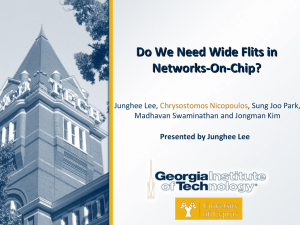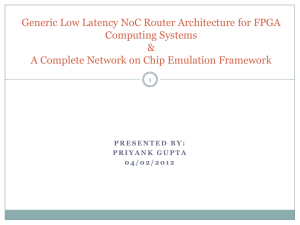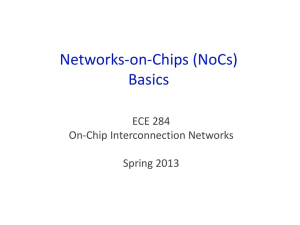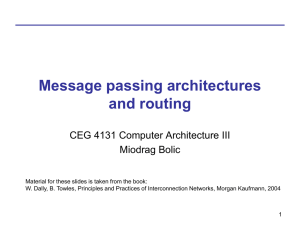Do We Need Wide Flits in Networks-On-Chip?
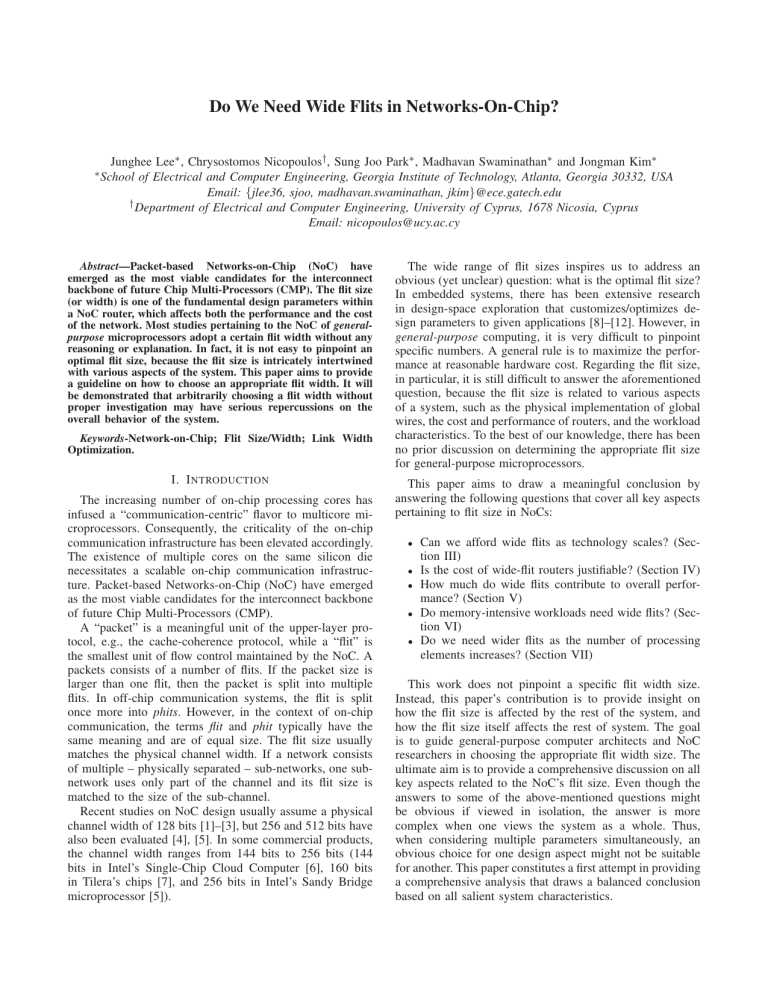
Do We Need Wide Flits in Networks-On-Chip?
Junghee Lee
∗
, Chrysostomos Nicopoulos
†
, Sung Joo Park
∗
, Madhavan Swaminathan
∗ and Jongman Kim
∗
∗
School of Electrical and Computer Engineering, Georgia Institute of Technology, Atlanta, Georgia 30332, USA
Email: { jlee36, sjoo, madhavan.swaminathan, jkim } @ece.gatech.edu
†
Department of Electrical and Computer Engineering, University of Cyprus, 1678 Nicosia, Cyprus
Email: nicopoulos@ucy.ac.cy
Abstract —Packet-based Networks-on-Chip (NoC) have emerged as the most viable candidates for the interconnect backbone of future Chip Multi-Processors (CMP). The flit size
(or width) is one of the fundamental design parameters within a NoC router, which affects both the performance and the cost of the network. Most studies pertaining to the NoC of generalpurpose microprocessors adopt a certain flit width without any reasoning or explanation. In fact, it is not easy to pinpoint an optimal flit size, because the flit size is intricately intertwined with various aspects of the system. This paper aims to provide a guideline on how to choose an appropriate flit width. It will be demonstrated that arbitrarily choosing a flit width without proper investigation may have serious repercussions on the overall behavior of the system.
Keywords -Network-on-Chip; Flit Size/Width; Link Width
Optimization.
I. I NTRODUCTION
The increasing number of on-chip processing cores has infused a “communication-centric” flavor to multicore microprocessors. Consequently, the criticality of the on-chip communication infrastructure has been elevated accordingly.
The existence of multiple cores on the same silicon die necessitates a scalable on-chip communication infrastructure. Packet-based Networks-on-Chip (NoC) have emerged as the most viable candidates for the interconnect backbone of future Chip Multi-Processors (CMP).
A “packet” is a meaningful unit of the upper-layer protocol, e.g., the cache-coherence protocol, while a “flit” is the smallest unit of flow control maintained by the NoC. A packets consists of a number of flits. If the packet size is larger than one flit, then the packet is split into multiple flits. In off-chip communication systems, the flit is split once more into phits . However, in the context of on-chip communication, the terms flit and phit typically have the same meaning and are of equal size. The flit size usually matches the physical channel width. If a network consists of multiple – physically separated – sub-networks, one subnetwork uses only part of the channel and its flit size is matched to the size of the sub-channel.
Recent studies on NoC design usually assume a physical channel width of 128 bits [1]–[3], but 256 and 512 bits have also been evaluated [4], [5]. In some commercial products, the channel width ranges from 144 bits to 256 bits (144 bits in Intel’s Single-Chip Cloud Computer [6], 160 bits in Tilera’s chips [7], and 256 bits in Intel’s Sandy Bridge microprocessor [5]).
The wide range of flit sizes inspires us to address an obvious (yet unclear) question: what is the optimal flit size?
In embedded systems, there has been extensive research in design-space exploration that customizes/optimizes design parameters to given applications [8]–[12]. However, in general-purpose computing, it is very difficult to pinpoint specific numbers. A general rule is to maximize the performance at reasonable hardware cost. Regarding the flit size, in particular, it is still difficult to answer the aforementioned question, because the flit size is related to various aspects of a system, such as the physical implementation of global wires, the cost and performance of routers, and the workload characteristics. To the best of our knowledge, there has been no prior discussion on determining the appropriate flit size for general-purpose microprocessors.
This paper aims to draw a meaningful conclusion by answering the following questions that cover all key aspects pertaining to flit size in NoCs:
•
•
•
•
•
Can we afford wide flits as technology scales? (Section III)
Is the cost of wide-flit routers justifiable? (Section IV)
How much do wide flits contribute to overall performance? (Section V)
Do memory-intensive workloads need wide flits? (Section VI)
Do we need wider flits as the number of processing elements increases? (Section VII)
This work does not pinpoint a specific flit width size.
Instead, this paper’s contribution is to provide insight on how the flit size is affected by the rest of the system, and how the flit size itself affects the rest of system. The goal is to guide general-purpose computer architects and NoC researchers in choosing the appropriate flit width size. The ultimate aim is to provide a comprehensive discussion on all key aspects related to the NoC’s flit size. Even though the answers to some of the above-mentioned questions might be obvious if viewed in isolation, the answer is more complex when one views the system as a whole. Thus, when considering multiple parameters simultaneously, an obvious choice for one design aspect might not be suitable for another. This paper constitutes a first attempt in providing a comprehensive analysis that draws a balanced conclusion based on all salient system characteristics.
Figure 1.
The assumed NoC router architecture and its salient parameters
[ v : number of virtual channels per port, d : buffer depth, c : physical channel width in bits, p : number of ports, t : number of pipeline stages].
II. P REAMBLE
Since we cannot cover all variety of architectures in this study, we have to assume a well-established and widely used
NoC setting, which is the conventional wormhole router.
Figure 1 shows the router architecture assumed in this paper.
The main duty of the router is to forward an incoming flit to one of several output ports. The output ports are connected to adjacent routers through physical links, whose width is c bits, and one output port is connected to a network interface controller. There are p input ports and p output ports in a router. Each input port has v buffers in parallel, which corresponds to v virtual channels. The depth of one buffer is d flits. It takes t cycles from flit arrival to departure
(excluding contention).
Alternatively, there are routers that do not employ a switch, such as ring-based routers [13]–[17] and rotary routers [18], [19], but they are not considered here, since they are more specialized and not as widely used as the generic design assumed in this work.
To deliver a message, the router augments additional bits
(overhead) to the packets, which specify the destination of the packet and include implementation-dependent control fields, e.g., packet type and virtual channel ID. As previously mentioned, if the packet is larger than the flit size, it is split into multiple flits. Figure 2 illustrates how a packet is handled within a router. The header overhead is h bits and the payload size is l bits. The total number of bits in a packet is h + l bits. If this size is larger than the flit size, f , the packet is split into N flits. If h + l is not a multiple of f , the last flit is not fully utilized.
The flit size f may or may not be identical to the physical channel width c . Unless otherwise specified, we will assume a single physical network, where f = c .
To quantify an optimal/ideal flit width, a series of experiments are conducted. We employ Simics/GEMS [20], [21], a cycle-accurate full-system simulator, for the experiments.
The parameters used for the experiments are shown in
Table I. The default values shown in the second column are used throughout, unless otherwise specified. The number
Figure 2.
Splitting a packet into flits [ h : header overhead, l : payload size, f : flit size, N : number of flits].
Table I
S YSTEM PARAMETERS
Parameter
Processor
Number of processors
Operating system
L1 cache size
L1 cache number of ways
L1 cache line size
L2 cache (shared)
MSHR size
Main memory
Cache coherence protocol
Benchmark
Topology
Number of virtual channels ( v )
Buffer depth ( d )
Number of pipeline stages ( t )
Number of ports ( p )
Header overhead ( h )
Default value x86 Pentium 4
64
Linux Fedora
32 KB
4
64 B
16 MB, 16-way, 128-B line
32 for I- and 32 for D-cache
2 GB SDRAM
MOESI-directory
PARSEC
2D mesh
4
5
3
8 flits per virtual channel
16 bits of Virtual Channels (VCs) per port is three, because the
MOESI-directory cache coherence protocol requires at least
3 VCs to avoid protocol-level deadlocks [22].
III. G LOBAL W IRES
As technology advances, feature sizes shrink well into the nanometer regime. If we keep the same flit size, the area overhead of the global wires, which connect routers, decreases. However, if the power consumption is also taken into consideration, the result is quite the opposite.
Table II shows projected technology parameters. The values for 65 nm and 45 nm technologies are derived from
ITRS 2009 [23], while those for 32 nm and 22 nm are from
ITRS 2011 [24]. The chip size remains the same, regardless of technology scaling, but the number of transistors in a chip increases as technology advances. The wiring pitch of global wires also shrinks as the feature size shrinks. The
“power index” parameter refers to the power consumption per GHz per area of wires [24]. It is the average of the power consumption of local, intermediate, and global wires [24].
The power index increases, because the coupling capacity increases as the feature size decreases. As for the total chip power, it decreases, because the supply voltage decreases.
We can compute the power consumption of the global wires ( γ ) by multiplying the power index ( y ) by the area of global wires ( β ). The area of global wires ( β ) is computed as the product of the total wire length ( α ), wiring pitch ( x ), and the number of wires (flit size). The wiring pitch of the global wires is given in the table. It is assumed that the same number of wires is used across the different technologies. To estimate the total wire length, we assume that the number
Table II
P ROJECTION OF THE POWER CONSUMPTION OF GLOBAL WIRES . [23],
[24]
1
2
3
4
Item
Technology
Unit nm mm
2
Chip size
Transistors ( w )
Global wiring pitch ( x )
Power index ( y )
Total chip power ( z )
Supply voltage
MTRs nm
W/GHz · cm
2
W
V
Normalized total wire length ( α )
1
Normalized wire area ( β )
2
Normalized wire power ( γ )
3
Normalized power portion ( δ )
4
α
β
γ
δ
∝
∝
∝
∝
√ w
α
×
β ×
γ/z x
× number of bits (flit size) y × clock frequency
65
260
1106
290
1.6
198
1.10
1.00
1.00
1.00
1.00
45
Value
32
260
2212
205
1.8
146
0.95
1.41
0.99
1.12
1.53
260
4424
140
2.2
158
0.87
2.00
0.97
1.33
1.66
22
260
8848
100
2.7
143
0.80
2.83
0.97
1.65
2.28
of nodes in the network increases at the same rate as the number of transistors, since the chip size remains the same, regardless of the technology used. The normalized total wire length ( α ) is computed to be proportional to the square root of the number of transistors ( w ). The normalized wire area ( β ) is the normalized total wiring length ( α ) times the global wiring pitch ( x ) times the number of wires (flit size).
Since the number of wires is assumed to be the same, the normalized wire area is proportional to the product of the total wire length and the global wiring pitch. Multiplying the normalized wire area ( β ) by the power index ( y ) gives us the power consumption of the wires per GHz. Assuming the clock frequency is the same, we can regard it as the normalized wire power ( γ ). The power portion ( δ ) is the normalized wire power ( γ ) over the total chip power ( z ).
As a conclusion, we can see that the power portion of the global wires ( δ ) increases as technology scales. This means that if we want to keep the flit size the same, we need to increase the power budget for the global wires. Therefore, technology scaling does not allow for a direct widening of the flits .
IV. C OST OF R OUTER
It is well-known that the flit buffers and the crossbar switch are the two major components that determine the area and power consumption of a router [13]. Both the area cost and power consumption of the buffers increase linearly with the physical channel width [25]. Those of the crossbar increase quadratically with the physical channel width [25].
The following equations summarize the relationship between the cost of the buffer (1) and the crossbar switch (2).
C buf f er refers to either the area cost, or the power consumption of the buffer, and C switch refers to the crossbar switch.
C buf f er
∝ c × v × d (1)
C switch
∝ c 2 × p 2
(2)
From these equations we can expect that the cost of the router increases at a greater-than-linear rate. Figure 3 puts the area cost into perspective. A detailed breakdown of the
16
14
12
10
8
6
4
2
0
Buffer
Switch
Allocator
Linear Increase
Flit size (bits)
Figure 3.
The increasing cost of a router with increasing flit size (width).
The reference line indicates a linear increase, whereby the cost increases at the same rate as the flit size.
area cost of a router is reported in [26]. The buffer accounts for 37.58%, the switch for 53.13%, and the allocators
(arbiters) for 9.28% of the area of a 128-bit router [26].
If we double the flit size, the area of the router increases by 2.97 times. If the flit size becomes four times larger, the area of the router is 10.10 times larger than before.
The conclusion of this section is that the cost of a router increases sharply with the flit size, because the cost of the crossbar switch increases quadratically. If the performance improvement does not compensate for the increase in the cost, widening of the flit size is hard to justify.
V. L ATENCY
If we ignore traffic congestion, the latency of a packet can be estimated by the following equation [27] (the congestion will be considered separately in Section VII). Parameter H denotes the hop count. Note that even if a packet spans multiple flits, the latency is not a multiple of the number of flits, since the router is pipelined.
L packet
= ( t + 1) × H + t s
× ( N − 1) (3)
Parameter t s refers to the delay of the switch, which is equal to one cycle in this analysis. Parameter N can be rewritten in terms of flit size f as follows.
N = h + l f
(4)
From these equations, we can infer the following: for large networks, the term ( t + 1) × H would dominate the latency. Cost budget permitting, devoting resources to reduce the number of pipeline stages ( t ) by using preconfiguration [2], [3], [28], or prediction [29]–[31], would be more cost-effective than widening the flit size. We can also consider reducing the hop count ( H ) by employing alternative topologies [32].
The network traffic usually consists of packets of different sizes. Let us denote l s to be the size of the shortest packet and l l of the longest one. When we increase the flit size
( f ), it is expected that the performance will improve until f reaches l s
+ h . The improvement slows down after l s
+ h until l l
+ h , and there is no more improvement after l l
+ h .
Let us put this into perspective by using the default values given in Table I. The number of processors is assumed to be 64 ( 8 × 8 mesh). Then, the average hop count ( H ) is
3
2.5
2
1.5
1
0.5
0
Control
Data
Mix
Linear Increase
Flit size (bits)
(a) 8
×
8 network
3
2.5
2
1.5
1
0.5
0
Control
Data
Mix
Linear Increase
Flit size (bits)
(b) 4
×
4 network
Figure 4.
Overall speedup with increasing flit size (width).
approximately 8 ( = (8 + 8) / 2 ). The number of pipeline stages ( t ) is 4 (typical) and the header overhead ( h ) is 16 bits. In the MOESI-directory protocol, there are two types of packets: control packets of length 64 bits ( l s packets of length 576 bits ( l l
).
) and data
Figure 4(a) shows the speedup results. Since the profiling information of the applications of the PARSEC benchmark suite [33] in Table III shows that the control packets account for 70% of network traffic, the “Mix” curve in Figure 4 is the weighted average of 70% the latency of control packets and 30% the latency of data packets. Again, a reference line is added that indicates linear increase.
The performance improvement of “Mix” from 32 bits to
64, 64 to 96, and 96 to 128 is 7.83%, 3.83%, and 1.46%, respectively. After 128 bits, the performance improvement is less than 1%. As expected, the performance improvement is relatively large until the flit size is less than around 80 bits
( l s
+ h = 64 + 16). However, the performance improvement is far less than the linear increase. If we reduce the network size, the latency is more sensitive than in a larger network.
Figure 4(b) shows the results of a 4 × 4 network. The speedup is still far less than linear. For the weighted average (“Mix”), we can hardly see any performance improvement beyond 96 bits.
The conclusion of this section is that the performance improvement achieved by widening the flit size saturates beyond a certain point. The suggested rule of thumb is that the flit size should be matched to the shortest packet size
( f = l s
+ h ).
VI. W ORKLOAD C HARACTERISTICS
The analysis of the previous section does not consider traffic congestion. In other words, it is valid only at low injection rates. Indeed, it has been reported that the injection rates of real workloads cannot be high, because of the selfthrottling effect [34].
Table III
P ROFILE OF THE APPLICATIONS IN THE PARSEC BENCHMARK
SUITE [33].
Application blackscholes bodytrack ferret fluidanimate freqmine streamcluster swaptions vips x264
Cache misses
/Kcycle/node
0.41
0.67
0.26
0.24
0.28
0.48
0.38
0.23
0.28
Injected packets
/Kcycle/node
2.21
3.56
1.43
1.35
1.48
2.42
2.04
1.27
1.54
Percentage of control packets
73.46%
75.53%
71.60%
71.13%
72.27%
72.10%
72.85%
70.64%
71.26%
The cache controller injects packets into the network when the cache is accessed. Upon a cache miss, the processor should be stalled (sooner or later). Even though the processor may need to issue more memory accesses, it cannot do so until pending cache lines are filled. Therefore, the injection rate cannot be high, even for memory-intensive workloads.
Our experimental results confirm this argument. Table III summarizes the characteristics of the applications of the
PARSEC benchmark suite [33]. PARSEC benchmarks do not target a certain application domain; they represent a variety of diverse application domains [33].
From the perspective of the network, the injection rate is only affected by the cache misses per cycle. The second column of Table III shows the number of cache misses per
1,000 cycles per node. We can see that the cache miss rate is co-related with the injection rate. The third column shows the injection rate in terms of packets/1,000-cycles/node. The highest injection rate is only 3.56 packets/1,000-cycles/node
(0.00356 packets/cycle/node), which is far less than the typical saturation point of a NoC. The last column shows the percentage of the control packets among all network traffic.
The percentage does not vary much with the application.
The conclusion of this section is that we can keep the rule of thumb of Section V, at least up to 64 cores, because the injection rate is very low in real workloads.
VII. T HROUGHPUT
If the number of cores increases to the tens or hundreds, the network can saturate even at low injection rates. To accommodate a large number of cores, a high-throughput network is necessary.
One way to increase the throughput of a network is to increase the flit size. Again, widening the flit size is not a cost-effective way to increase the throughput, because of fragmentation . The discrepancy between the packet size and the flit size limits utilization.
The utilization ( U ) of the physical channel is estimated by equation (5) below. Parameter l denotes the payload size, N is the number of flits computed by equation (4), and f is the flit size. Parameter U indicates how many bits are actually used for delivering the payload among all transmitted bits:
U = l
N × f
(5)
1
0.9
0.8
0.7
0.6
0.5
0.4
0.3
0.2
0.1
0
Control
Data
Mix
Flit size (bits)
Figure 5.
Physical channel utilization with increasing flit size (width).
To put this into perspective, we analyze the utilization of the control and data packets of the MOESI-directory cache coherence protocol.
We have drawn the rule of thumb of Section V from the fact that the latency improvement saturates when the flit size
( f ) exceeds the smallest packet size ( l s
+ h ). When also considering the utilization, we arrive at the same conclusion.
Figure 5 shows that the overall utilization (“Mix”) gradually decreases (as the flit size increases) when the flit size
( f ) exceeds the smallest packet size ( l s
+ h ). How fast it decreases depends on how much the smallest packet type is accounted for among all network traffic. Regardless, the concluding remark is that the overall utilization decreases with increasing flit size when f exceeds l s
+ h , because of fragmentation.
The network throughput can be enhanced in different ways. Deepening the buffers, reducing the number of pipeline stages, and adding more virtual channels per port all contribute to the throughput. However, it is true that the performance improvement achieved through such techniques also saturates beyond a point.
If the budget allows, or if the only remaining way to improve throughput is to widen the physical channel width
( c ), we may consider widening the flit size ( f ). An alternative way to exploit the wide physical channel is to employ separate networks, with each one using only a part of the physical channel. Figure 6 compares the throughput of (1) one physical network with wide flits ( c = f ), and (2) two physically separated networks with narrow flits ( c = 2 × f ).
The baseline is one network with 80-bit flits. According to the profile of Table III, 70% control packets – whose size is
64 bits – and 30% data packets – whose size is 576 bits – are injected. The traffic pattern is uniform random. The flit size is set to 80 bits by our rule of thumb ( l s
+ h = 64+16 = 80 ).
When the flit size is doubled (one 160-bit network), we can see that the throughput improves. However, it is clearly evident that the physically separated networks (two 80bit networks) offer better throughput than the monolithic network. In the physically separated networks, one network carries only control packets and the other network carries data packets. Even though the two networks are not evenly utilized, they offer better throughput than the monolithic network. Recall that the router cost of one 160-bit network is approximately three times larger than that of a baseline
80-bit network, whereas the cost of two physically separated
80-bit networks is two times larger.
100
80
60
40
20
0
0
One 80-bit network
One 160-bit network
Two 80-bit networks
0.02
0.04
0.06
0.08
Injection rate (packets/cycle/node)
0.10
Figure 6.
Throughput comparison of one physical network with wide flits vs. two physically separated networks with narrow flits.
The conclusion of this section is that the widening of the flit size is not a cost-effective way to enhance throughput, because of fragmentation. If a wide physical channel is available, it is better to employ physically separated networks than to widen the flit size.
VIII. C ONCLUSION
The answers to the key questions posed in the introduction of this paper have been answered. Even though technology scales persistently, the number of global wires cannot grow as rapidly. The cost of a router increases sharply with increasing flit size, because the overhead of the crossbar switch increases quadratically. The performance improvement achieved by widening the flit size does not outweigh the increase in the cost. Increasing the flit size until the size of the smallest packet type is reached improves performance, but the performance improvement saturates as the flit size exceeds the smallest packet size. At least up to 64 cores, one need not increase the flit size to support high injection rates, because the injection rate of real applications is very low, due to the self-throttling effect. To enhance throughput, we may consider widening the physical channel width. However, employing physically separated networks to utilize this extra width is more cost-effective than widening the flit size of a monolithic network.
This paper provides a comprehensive discussion on all key aspects pertaining to the NoC’s flit size. This exploration could serve as a quick reference for the designers/architects of general-purpose multi-core microprocessors who need to decide on an appropriate flit size for their design.
As a final conclusion, the suggested rule of thumb is to match the flit size to the smallest packet type’s size, plus the required header (network) overhead.
R EFERENCES
[1] A. Kumar, L.-S. Peh, P. Kundu, and N. K. Jha, “Express virtual channels: towards the ideal interconnection fabric,” in
Proceedings of the 34th International Symposium on Computer Architecture , 2007.
[2] A. Kumary, P. Kunduz, A. Singhx, L.-S. Pehy, and N. Jhay,
“A 4.6Tbits/s 3.6GHz single-cycle NoC router with a novel switch allocator in 65nm CMOS,” in Proceedings of the 25th
International Conference on Computer Design , 2007, pp. 63
–70.
[3] M. Hayenga, N. E. Jerger, and M. Lipasti, “SCARAB: a single cycle adaptive routing and bufferless network,” in
Proceedings of the 42nd International Symposium on Microarchitecture , 2009.
[4] R. Das, S. Eachempati, A. Mishra, V. Narayanan, and C. Das,
“Design and evaluation of a hierarchical on-chip interconnect for next-generation CMPs,” in Proceedings of the 15th
International Symposium on High Performance Computer
Architecture , 2009, pp. 175 –186.
[5] C. Fallin, X. Yu, G. Nazario, and O. Mutlu, “A highperformance hierarchical ring on-chip interconnect with low-cost routers,” Computer Architecture Lab (CALCM),
Carnegie Mellon University, Tech. Rep., 2011.
[6] J. Howard, S. Dighe, S. Vangal, G. Ruhl, N. Borkar, S. Jain,
V. Erraguntla, M. Konow, M. Riepen, M. Gries, G. Droege,
T. Lund-Larsen, S. Steibl, S. Borkar, V. De, and R. Van
Der Wijngaart, “A 48-core IA-32 processor in 45 nm CMOS using on-die message-passing and DVFS for performance and power scaling,” IEEE Journal of Solid-State Circuits , vol. 46, no. 1, pp. 173 –183, jan. 2011.
[7] D. Wentzlaff, P. Griffin, H. Hoffmann, L. Bao, B. Edwards, C. Ramey, M. Mattina, C.-C. Miao, J. Brown, and
A. Agarwal, “On-chip interconnection architecture of the tile processor,” IEEE Micro , vol. 27, no. 5, pp. 15 –31, sept.-oct.
2007.
[8] C.-L. Chou and R. Marculescu, “User-centric design space exploration for heterogeneous network-on-chip platforms,” in
Proceedings of Design, Automation Test in Europe Conference Exhibition , april 2009, pp. 15 –20.
[9] R. K. Jena, M. Aqel, and P. Mahanti, “Network-on-chip design space exploration: A PSO based integrated approach,”
European Journal of Scientific Research , vol. 64, no. 1, pp.
5 –18, 2011.
[10] L. Indrusiak, L. Ost, L. Moller, F. Moraes, and M. Glesner,
“Applying UML interactions and actor-oriented simulation to the design space exploration of network-on-chip interconnects,” in Proceedings of the IEEE Computer Society Annual
Symposium on VLSI , april 2008, pp. 491 –494.
[11] D. Matos, G. Palermo, V. Zaccaria, C. Reinbrecht, A. Susin,
C. Silvano, and L. Carro, “Floorplanning-aware design space exploration for application-specific hierarchical networks onchip,” in Proceedings of the 4th International Workshop on
Network on Chip Architectures , ser. NoCArc ’11, 2011, pp.
31–36.
[12] H. G. Lee, N. Chang, U. Y. Ogras, and R. Marculescu, “Onchip communication architecture exploration: A quantitative evaluation of point-to-point, bus, and network-on-chip approaches,” ACM Trans. Des. Autom. Electron. Syst.
, vol. 12, no. 3, pp. 23:1–23:20, May 2008.
[13] J. Kim, “Low-cost router microarchitecture for on-chip networks,” in Proceedings of the 42nd International Symposium on Microarchitecture , dec. 2009, pp. 255 –266.
[14] M. Holliday and M. Stumm, “Performance evaluation of hierarchical ring-based shared memory multiprocessors,” IEEE
Transactions on Computers , vol. 43, pp. 52–67, January 1994.
[15] F. Sibai, “Adapting the hyper-ring interconnect for manycore processors,” in International Symposium on Parallel and
Distributed Processing with Applications , 2008, pp. 649 –654.
[16] J.-H. Chuang and W.-C. Chao, “Torus with slotted rings architecture for a cache-coherent multiprocessor,” in Proceedings of the 1994 International Conference on Parallel and
Distributed Systems , 1994, pp. 76–81.
[17] S. Bourduas and Z. Zilic, “A hybrid ring/mesh interconnect for network-on-chip using hierarchical rings for global routing,” in Proceedings of the First International Symposium on
Networks-on-Chip , 2007, pp. 195–204.
[18] P. Abad, V. Puente, and J.-A. Gregorio, “MRR: Enabling fully adaptive multicast routing for CMP interconnection networks,” in Proceedings of the 15th International Symposium on High-Performance Computer Architecture , feb. 2009, pp.
355 –366.
[19] P. Abad, V. Puente, J. A. Gregorio, and P. Prieto, “Rotary router: an efficient architecture for cmp interconnection networks,” in Proceedings of the 34th International Symposium on Computer Architecture , 2007, pp. 116–125.
[20] Wind River Systems, http://www.windriver.com/.
[21] M. M. K. Martin, D. J. Sorin, B. M. Beckmann, M. R. Marty,
M. Xu, A. R. Alameldeen, K. E. Moore, M. D. Hill, and D. A.
Wood, “Multifacet’s general execution-driven multiprocessor simulator (gems) toolset,” SIGARCH Computer Architecture
News , vol. 33, p. 2005, 2005.
[22] S. Volos, C. Seiculescu, B. Grot, N. Khosro Pour, B. Falsafi, and D. M. G., “CCNoC: Specializing on-chip interconnects for energy efficiency in cache-coherent servers,” in Proceedings of the 6th International Symposium on Networks-on-
Chip , 2012.
[23] “International technology roadmap for semiconductors 2009,” http://public.itrs.net.
[24] “International technology roadmap for semiconductors 2011,” http://public.itrs.net.
[25] A. Kahng, B. Li, L.-S. Peh, and K. Samadi, “ORION 2.0:
A power-area simulator for interconnection networks,” IEEE
Transactions on Very Large Scale Integration (VLSI) Systems , vol. 20, no. 1, pp. 191 –196, jan. 2012.
[26] D. Park, S. Eachempati, R. Das, A. Mishra, Y. Xie, N. Vijaykrishnan, and C. Das, “MIRA: A multi-layered on-chip interconnect router architecture,” in Proceedings of the 35th
International Symposium on Computer Architecture , june
2008, pp. 251 –261.
[27] J. Duato, S. Yalamanchili, and L. Ni, Interconnection networks .
Margan Kaufmann, 2003.
[28] N. D. E. Jerger, L.-S. Peh, and M. H. Lipasti, “Circuitswitched coherence,” in Proceedings of the Second
ACM/IEEE International Symposium on Networks-on-Chip ,
2008, pp. 193–202.
[29] G. Michelogiannakis, D. Pnevmatikatos, and M. Katevenis,
“Approaching ideal NoC latency with pre-configured routes,” in Proceedings of the First International Symposium on
Networks-on-Chip , 2007.
[30] H. Matsutani, M. Koibuchi, H. Amano, and T. Yoshinaga,
“Prediction router: Yet another low latency on-chip router architecture,” in Proceedings of the IEEE 15th International
Symposium on High Performance Computer Architecture ,
2009, pp. 367 –378.
[31] J. Kim, C. Nicopoulos, and D. Park, “A gracefully degrading and energy-efficient modular router architecture for on-chip networks,” SIGARCH Computer Architecture News , vol. 34, no. 2, pp. 4–15, 2006.
[32] B. Grot, J. Hestness, S. Keckler, and O. Mutlu, “Express cube topologies for on-chip interconnects,” in Proceedings of the 15th International Symposium on High Performance
Computer Architecture , feb. 2009, pp. 163 –174.
[33] C. Bienia, “Benchmarking modern multiprocessors,” Ph.D.
dissertation, Princeton University, January 2011.
[34] T. Moscibroda and O. Mutlu, “A case for bufferless routing in on-chip networks,” ACM SIGARCH Computer Architecture
News , vol. 37, no. 3, pp. 196 –207, june 2009.

